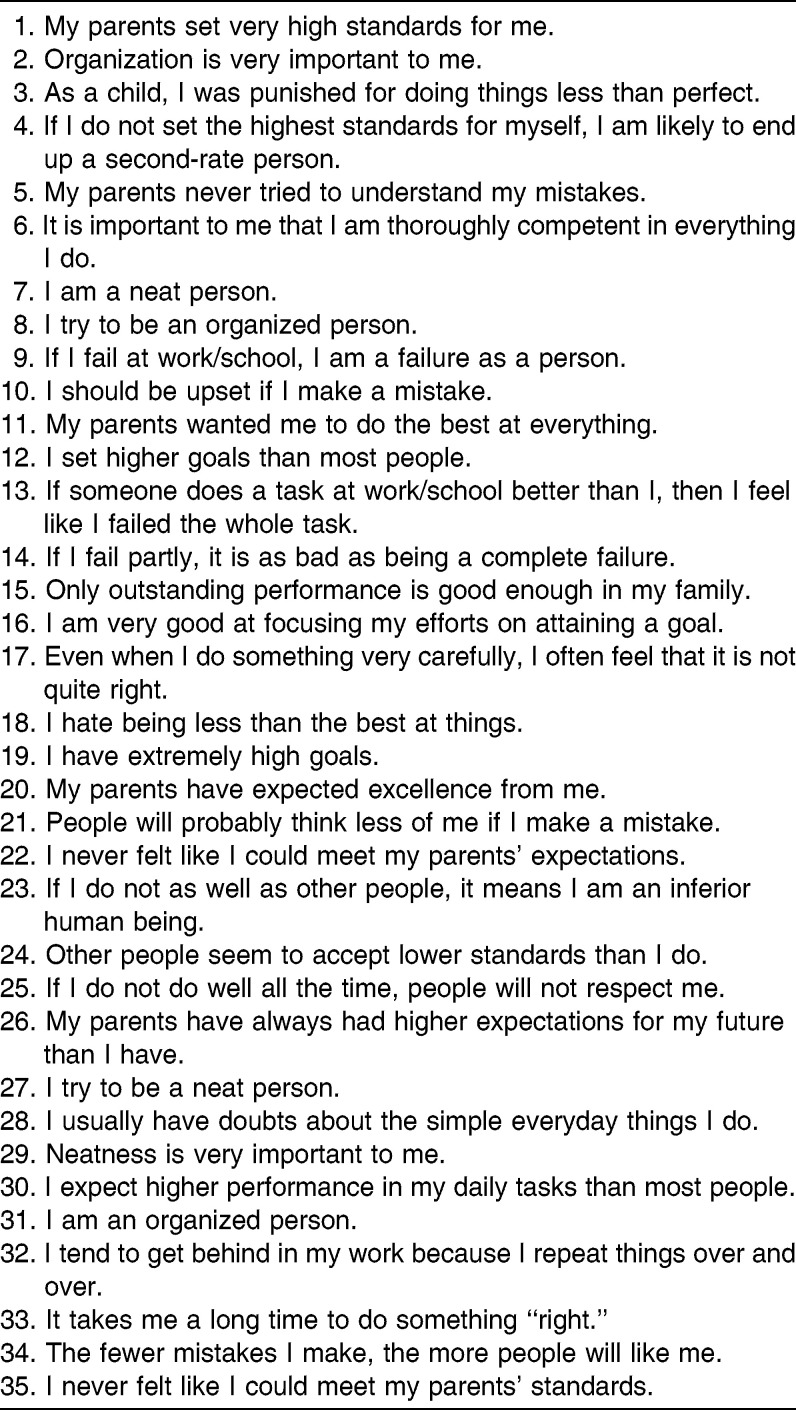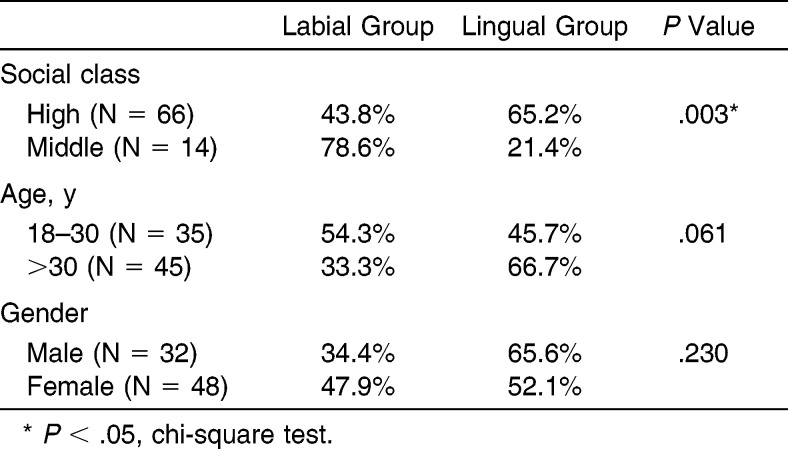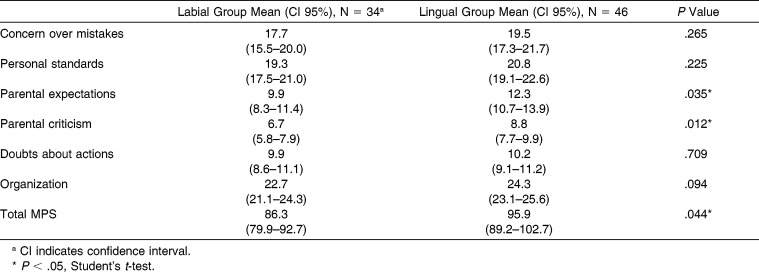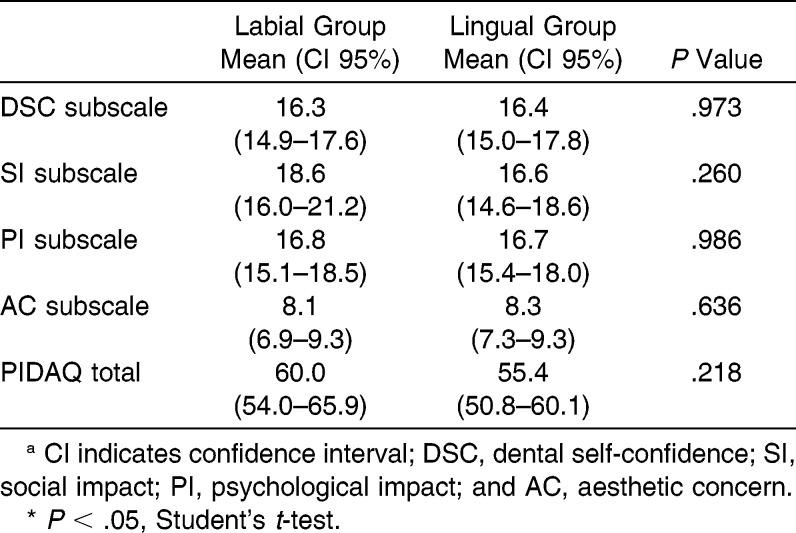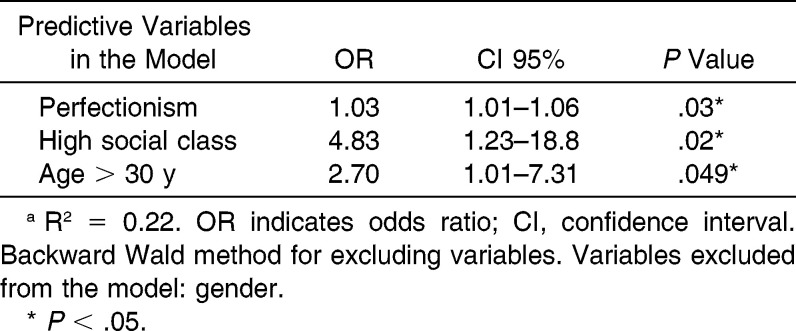Abstract
Objective:
To examine some of the patients' psychological traits in relation to their levels of perfectionism and their body image, and to discover whether these differ between lingual and labial orthodontic patients.
Materials and Methods:
A cross-sectional study was designed with a consecutive sample of 80 patients attending a private orthodontic office. Three questionnaires were used to assess the patients' body image and level of perfectionism. The mean age was 33 years. The men numbered 32 and the women 48. The validated Spanish version of the Psychosocial Impact of Dental Aesthetic Questionnaire (PIDAQ) was used to assess the psychosocial impact of their dental esthetics. The Multidimensional Perfectionism Scale (MPS) was used to assess how perfectionist the patients were. A version of the Multidimensional Body-Self Relations Questionnaire (MBSRQ) was used for assessment of their body image. Student's t-test was used to compare the means and 95% confidence intervals (P < .05), and a logistic regression model was used for multivariate analysis.
Results:
The PIDAQ (55.4 vs 60, P = .218) and MBSRQ (128.7 vs 125.9, P = .523) results of the patients who chose lingual orthodontics did not differ significantly from those who opted for labial orthodontics. However, the MPS scores of the lingual orthodontic patients were significantly higher (95.9 vs 86.3, P = .044), and high social class, over 30 years of age, and perfectionist traits were significant independent variables in this group.
Conclusions:
This pilot study may indicate that lingual orthodontic patients are more perfectionists than labial orthodontic patients.
Keywords: Perfectionism, Lingual orthodontics, Adult patients
INTRODUCTION
Obviously, most patients who want orthodontic treatment are concerned about the appearance of their smile, and therefore make demands on their orthodontists. Nevertheless, a considerable number of authors have stated that patients who ask for lingual orthodontics are generally more exacting than those who choose labial orthodontics. Rummel et al.1 observed that lingual orthodontic patients demand greater precision in the finishing, both because it is easier for these patients to evaluate the progress being made, since the brackets do not cover the facial surfaces of the teeth and because the added cost of lingual orthodontics further intensifies their demand for excellence. Fillion2 highlighted that lingual bracket wearers usually have a special attitude to orthodontic treatment, in terms of their adjustment to the brackets, the demands of their work, or their psychological traits. Some authors have suggested examining the behavior and expectations of lingual orthodontic patients. Indeed, Wiechmann et al.3 concluded that a validated psychological questionnaire should be developed especially for patients seeking lingual orthodontic treatment. Earlier, Sinclair et al.4 mentioned that for patients who requested lingual orthodontics, it would be useful to analyze certain aspects of their personality that might lead to a negative response to lingual treatment, since those with high anxiety or reaction scores in psychological evaluations were likely to report more generalized pain and tongue soreness after placement of lingual brackets. Alexander et al.5 had already observed that lingual orthodontic patients shared certain traits, generally being highly motivated but very concerned about their appearance. They also highlighted that these patients usually demand specific appointment times that will not affect their busy working day.
In a recent pilot study, Cooper-Kazaz et al.6 observed that patients who chose lingual orthodontics or clear aligner appliances exhibited more obsessive-compulsive, anxious, or narcissistic traits, although the differences were not statistically significant.
In plastic surgery, psychological evaluation of patients who undergo surgery is frequently undertaken.7 Some authors have analyzed perfectionism traits in cosmetic surgery patients.8,9 Psychological evaluation has also been performed in patients undergoing orthognathic surgery, using questionnaires to assess the body image or the personality traits.10,11 The Multidimensional Body-Self Relations Questionnaire (MBSRQ) has been validated in a sample of cosmetic surgery patients. A comparison between these patients and college students found significant differences between them.12 The Psychosocial Impact of Dental Aesthetic Questionnaire (PIDAQ) developed by Klages et al.14 has been used by many authors to evaluate the psychosocial impact of malocclusion.13,14
Several authors agree that patients who opt for lingual orthodontics have high purchasing power, and we should not forget that some have found an association between social class and the esthetic impact of malocclusion, which they have found greater among the upper classes.5,15
The objective of this study was to examine certain psychological traits in order to discover whether lingual orthodontic patients and labial orthodontic patients presented differences in perfectionism, psychosocial impact of their dental esthetics, and body image.
MATERIALS AND METHODS
A cross-sectional study was designed with a consecutive sample of 80 patients attending a private office in the city of Valencia (Spain) for orthodontic treatment. The study was conducted over 12 months, from June 2012 to June 2013, at a single office that specializes in orthodontics.
Three self-reported questionnaires were used to assess the patients' body image and level of perfectionism. The questionnaires were delivered by the dental assistant prior to initiating the orthodontic treatment. The purpose of the study and the instructions were explained in the questionnaires themselves. The study was approved by the ethics committee of the University of Valencia Faculty of Medicine and Dentistry.
All adult patients who were about to receive labial or lingual orthodontic treatment were included in the study. None of them refused to take part, and only one questionnaire was excluded because it had not been completed correctly. Each person's name, age, and gender were recorded, and whether they had received any previous orthodontic treatment. Those who were wearing brackets at the time of the study were excluded, but not those who had been treated in the past. All of the patients included in the study were at liberty to choose which type of device (lingual or labial) they would wear. The type of treatment in both arches was noted for each patient: lingual orthodontics, labial orthodontics, or no orthodontic device (where this was the case for one of the arches).
The mean age of all of the patients was 33.0 years (age range 18–58 years). By gender, 32 were men (40%) and 48 women (60%) for a total of 80 patients. Of these patients, 46 (57.5%) chose lingual orthodontics for one or both arches, and 34 (42.5%) chose labial orthodontics. Of those choosing lingual orthodontics, 45.7% were men and 54.3% women.
The mean age of the patients choosing lingual orthodontics was 34.8 years. The mean age of those choosing labial orthodontics was 30.4 years.
Variables Considered
Psychosocial impact of dental esthetics
The validated Spanish version of the PIDAQ was used.13 The PIDAQ is a psychometric instrument of 23 items, structurally composed of four subscales representing four domains, one positive and three negative: dental self-confidence (6 items), esthetic concern (3 items), psychological impact (6 items), and social impact (8 items). A five-point Likert scale is used, ranging from 1 (no impact of dental esthetics) to 5 (maximal impact of dental scales) for each item. The response options are as follows: 0 = not at all; 1 = a little; 2 = somewhat; 3 = strongly; and 4 = very strongly.14 The score for each scale was obtained by adding the corresponding items. The total questionnaire score (from 23 to 115 points) was obtained in the same way.
Level of perfectionism
This was assessed by a Spanish adaptation of the Multidimensional Perfectionism Scale (MPS).12,16 The MPS is a psychometric instrument of 35 items (Table 1) grouped into six dimensions: (1) personal standards, (2) concern over mistakes, (3) doubts about actions, (4) parental expectations, (5) parental criticism, and (6) organization. A five-point Likert scale is used, ranging from 1 to 5 each item. The score for each scale was obtained by adding the corresponding items. The total questionnaire score (from 35 to 175 points) was obtained in the same way.
Table 1.
Multidimensional Perfectionism Scale
Psychometric assessment of body image
This assessment was made with a shortened, adapted, and validated Spanish version of the MBSRQ.17,18 This version is a 45-item questionnaire, scored on a five-point Likert-type scale and grouped into four dimensions: (1) subjective importance of the body, (2) self-assessed physical attractiveness, (3) care of physical appearance, and (4) physical fitness-oriented behavior. The items in the latter dimension were not used in this study as they refer to physical fitness in terms of exercise and sports, and in light of previous research, we would not expect them to be related to the concern for body image that would lead a person to undergo a medical procedure.17 The score for each scale was obtained by adding the corresponding items. The total questionnaire score (from 45 to 225 points) was obtained in the same way.
Social class
The classification of social class was based on that of the UK Registrar.19 Social classes I, professional, and II, managerial/technical, were considered high. Social classes III N, skilled nonmanual, and III M, skilled manual, were considered middle. Social classes IV, partly skilled, and V, unskilled, were considered low. All others were not classified.
Age
The sample was divided into two age groups: 18 to 30 years and over 30 years of age.
Statistical Analysis
The Statistical Package for the Social Sciences (SPSS, version 18.0) was used for the data analysis. The sample was divided into two groups of orthodontic device wearers: lingual and labial. The chi-square test was used to check for significant differences in categorical variables in the initial sample distribution. To discover whether the two groups scored the three questionnaires differently, Student's t-test was used to compare the means, after checking for normal distribution. The means and 95% confidence intervals (significance level P < .05) are shown in the tables. The variables that showed significant differences were analyzed through a multivariate logistic regression model, using the backward Wald method. The goodness of fit of the model was measured by the Hosmer-Lemeshow test.
To assess the reliability of the three questionnaires, they were completed again a month later by 16 patients (20% of the sample), and the intraclass correlation coefficient (ICC) was calculated.
RESULTS
The sample distribution is shown in Table 2, where it can be seen that gender and age were in balance. The lingual orthodontic patients belonged to a higher social class (P < .05).
Table 2.
Sample Distribution
No significant differences between the high and middle social classes were found for the three questionnaires (MPS, MBSRQ, and PIDAQ) on applying Student's t-test. In the MPS, the means were 93.1 for the high social class and 83.9 for the middle class (P = .12). In the MBSRQ, means of 126.8 and 130.3 (P = .55), respectively, were obtained. In the PIDAQ, the means were 56.1 and 62.8 (P = .16), respectively.
Thirty percent of the sample had received orthodontic treatment in the past, but no significant differences were found between those who had been treated previously and those who had not. In the MPS, the mean for those who had not been treated in the past was 93.3, compared to 88.1 for those who had received treatment (P = .31). In the MBSRQ, the means were 126.6 and 129.4 (P = .57) and in the PIDAQ 55.8 and 60.8 (P = .22), respectively. The test-retest reliability of the questionnaires revealed an ICC of 0.91 for the MPS, 0.88 for the MBSRQ, and 0.92 for the PIDAQ.
The patients who chose lingual orthodontics also presented significantly higher scores on the MPS than those who opted for labial orthodontics, respectively 95.9 vs 86.3, with P = .044 on applying Student's t-test. The only dimensions with significant differences were parental expectations and parental criticism (Table 3).
Table 3.
Multidimensional Perfectionism Scale (MPS) Scores by Dimension in Lingual and Labial Orthodontic Patients
No significant differences between lingual and labial orthodontic patients were found for the MBSRQ (Table 4), although the lingual orthodontics group's scores were all higher.
Table 4.
Multidimensional Body-Self Relations Questionnaire (MBSRQ) Scores by Dimension in Lingual and Labial Orthodontic Patients
Equally, the two groups showed no differences in the psychological impact of dental esthetics measured by the PIDAQ (Table 5).
Table 5.
Psychosocial Impact of Dental Aesthetic Questionnaire (PIDAQ) Scores by Dimension in Lingual and Labial Orthodontic Patientsa
In the logistic regression model, the independent variables that proved significant for the choice of lingual orthodontics were perfectionism, high social class, and age over 30 years (Table 6).
Table 6.
Multivariate Logistic Regression Analysis With “Lingual Orthodontics” as the Dependent Variablea
DISCUSSION
According to recent studies, the prevalence of malocclusion in the young adult population—the usual age of patients who ask for lingual orthodontic treatment—is around 20%–30%.20 Many papers based on samples of lingual orthodontic patients have focused on examining their quality of life during the course of treatment but none have centered on investigating their psychological traits.3
In other fields, such as plastic surgery, psychological evaluation of patients who undergo surgery is frequently undertaken.7 We consider that this is an aspect which should be taken into account with conventional orthodontic patients as well, but particularly so with those who opt for lingual orthodontics, which costs two or three times more than conventional orthodontic treatment. In the present study, the profile of the lingual bracket wearers was similar to that of other studies: a mean age of 34.8 years and more women than men, although the differences in this respect were not significant.3,21,22
One of the difficulties we encountered in this study was the lack of previous research on the subject. Very recently, Cooper-Kazaz et al.6 observed obsessive-compulsive, anxious, or narcissistic types of personality traits among patients who chose lingual orthodontics or clear aligner appliances. This is a very important factor that orthodontists should bear in mind in view of the possible implications during treatment.
Moreover, psychological evaluation is frequent in the case of plastic surgery patients or orthognathic surgery patients.7–9 In fact, the MBSRQ has been used in a comparison between a sample of cosmetic surgery patients and college students. However, personality questionnaires are not as frequently used with orthodontic patients.
One of the limitations of this study is that including patients with a record of previous orthodontic treatment could be a possible source of bias. However, our results indicate that there were no statistically significant differences in perfectionism between patients who had received treatment previously and those who had not. Equally, those of high social class did not exhibit greater perfectionism than middle class patients. The sample size was moderate, although adequate for a pilot study.
We thought that the patients would be unwilling to fill in the questionnaires, but once the study objectives had been explained to them, none of them refused to take part. The lingual orthodontic patients in this study were more perfectionists than those who opted for conventional orthodontics, with statistically significant differences according to the MPS. These patients may have higher expectations and be more critical of the results, and they may be more likely to be dissatisfied. We have not found any similar studies, but these data coincide with clinical observations by various authors.1–3
Furthermore, these differences were particularly strong in some aspects of perfectionism that are considered characteristically negative, such as the perception of excessive parental expectations and criticism.23
On analyzing the PIDAQ results, we found no significant differences in the psychosocial impact of the dental esthetics of the two groups (P > .05). In the MBSRQ, all of the lingual orthodontic group scores were higher than those of the labial orthodontic group. However, these differences were not significant (P > .05).
The influence of purchasing power on the patient's choice of lingual or labial orthodontics should also be mentioned. In Spain, the cost of orthodontic treatment is borne entirely by the patient. Most of the patients who opted for lingual orthodontics belonged to a high social class and had a high educational level. Sardenberg et al.15 stated that higher-income patients usually have greater expectations of the results of treatment, although research by other authors such as Hohoff et al.21 contradicts this assertion. The present study shows that, to a significant degree, the patients who opt for lingual orthodontics belong to a high social class. However, it is important to note that there is no significant association between high social class and perfectionism. In the multivariate model, the two variables were significant and independent. Consequently, they both influence the choice of lingual orthodontics but are not related to each other.
CONCLUSIONS
Our results appear to indicate that neither the psychosocial impact of the patient's dental esthetics nor the patient's assessment of his or her body image differs between lingual and labial orthodontic patients.
However, lingual orthodontic patients do exhibit more perfectionist traits than patients who choose labial orthodontic treatment.
REFERENCES
- 1.Rummel V, Wiechmann D, Sachdeva RC. Precision finishing in lingual orthodontics. J Clin Orthod. 1999;33:101–113. [PubMed] [Google Scholar]
- 2.Fillion D. Improving patient comfort with lingual brackets. J Clin Orthod. 1997;31:689–694. [PubMed] [Google Scholar]
- 3.Wiechmann D, Gerss J, Stamm T, Hohoff A. Prediction of oral discomfort and dysfunction in lingual orthodontics: a preliminary report. Am J Orthod Dentofacial Orthop. 2008;133:359–364. doi: 10.1016/j.ajodo.2006.03.045. [DOI] [PubMed] [Google Scholar]
- 4.Sinclair PM, Cannito MF, Goates LJ, Solomos LF, Alexander GM. Patient responses to lingual appliances. J Clin Orthod. 1986;10:396–404. [PubMed] [Google Scholar]
- 5.Alexander CM, Alexander RG, Sinclair PM. Lingual orthodontics: a status report. Part 6. Patient and practice management. J Clin Orthod. 1983;17:240–246. [PubMed] [Google Scholar]
- 6.Cooper-Kazaz R, Ivgi I, Canetti L, et al. The impact of personality on adult patients' adjustability to orthodontic appliances. Angle Orthod. 2013;83:76–82. doi: 10.2319/010312-6.1. [DOI] [PMC free article] [PubMed] [Google Scholar]
- 7.Cingi C, Songu M, Bal C. Outcomes research in rhinoplasty: body image and quality of life. Am J Rhinol Allergy. 2011;25:263–267. doi: 10.2500/ajra.2011.25.3649. [DOI] [PubMed] [Google Scholar]
- 8.Sherry SB, Hewitt PL, Flett GL. Perfectionism and undergoing cosmetic surgery. Eur J Plast Surg. 2007;29:349. doi: 10.1097/01.PRS.0000067100.50738.73. [DOI] [PubMed] [Google Scholar]
- 9.Sherry SB, Hewitt PL, Lee-Baggley DL, Flett GL, Besser A. Perfectionism and thoughts about having cosmetic surgery performed. J Appl Biobehav Res. 2004;9:244–257. [Google Scholar]
- 10.Cunningham SJ, Gilthorpe MS, Hunt NP. Are pre-treatment psychological characteristics influenced by pre-surgical orthodontics. Eur J Orthod. 2001;23:751–758. doi: 10.1093/ejo/23.6.751. [DOI] [PubMed] [Google Scholar]
- 11.Pabari S, Moles DR, Cunningham SJ. Assessment of motivation and psychological characteristics of adult orthodontic patients. Am J Orthod Dentofacial Orthop. 2011;140:263–272. doi: 10.1016/j.ajodo.2011.06.022. [DOI] [PubMed] [Google Scholar]
- 12.Carrasco A, Belloch A, Perpiñá C. La evaluación del perfeccionismo: utilidad de la Escala Multidimensional de Perfeccionismo en población española. Análisis y Modificación de Conducta. 2010;153:49–65. [Google Scholar]
- 13.Montiel-Company JM, Bellot-Arcís C, Almerich-Silla JM. Validation of the psychosocial impact of dental aesthetics questionnaire (PIDAQ) in Spanish adolescents. Med Oral Patol Oral Cir Bucal. 2013;18:e168–173. doi: 10.4317/medoral.18324. [DOI] [PMC free article] [PubMed] [Google Scholar]
- 14.Klages U, Claus N, Wehrbein H, Zentner A. Development of a questionnaire for assessment of the psychosocial impact of dental aesthetics in young adults. Eur J Orthod. 2006;28:103–111. doi: 10.1093/ejo/cji083. [DOI] [PubMed] [Google Scholar]
- 15.Sardenberg F, Martins MT, Bendo CB, et al. Malocclusion and oral health-related quality of life in Brazilian schoolchildren. Angle Orthod. 2013;83:83–89. doi: 10.2319/010912-20.1. [DOI] [PMC free article] [PubMed] [Google Scholar]
- 16.Frost R, Marten P, Lahart C, Rosenblate R. The dimensions of perfectionism. Cognit Ther Res. 1990;14:449–468. [Google Scholar]
- 17.Botella-García del Cid L, Ribas-Rabert E, Benito-Ruiz J. Evaluación psicométrica de la imagen corporal: validación de la versión española del multidimensional body self relations questionnaire (mbsrq) Revista Argentina de Clínica Psicológica. 2009;18:253–264. [Google Scholar]
- 18.Brown TA, Cash TF, Mikulka PJ. Attitudinal body image assessment: factor analysis of the Body-Self Relations Questionnaire. J Pers Assess. 1990;55:135–144. doi: 10.1080/00223891.1990.9674053. [DOI] [PubMed] [Google Scholar]
- 19.Alonso J, Pérez P, Sáez M, Murillo C. Validity of the occupation as an indicator of social class, according to the British Registrar General classification [in Spanish] Gac Sanit. 1997;11:205–213. doi: 10.1016/s0213-9111(97)71299-8. [DOI] [PubMed] [Google Scholar]
- 20.Bellot-Arcís C, Montiel-Company JM, Manzanera-Pastor D, Almerich-Silla JM. Orthodontic treatment need in a Spanish young adult population. Med Oral Patol Oral Cir Bucal. 2012;17:638–643. doi: 10.4317/medoral.17722. [DOI] [PMC free article] [PubMed] [Google Scholar]
- 21.Hohoff A, Stamm T, Ehmer U. Comparison of the effect on oral discomfort of two positioning techniques with lingual brackets. Angle Orthod. 2004;74:226–233. doi: 10.1043/0003-3219(2004)074<0226:COTEOO>2.0.CO;2. [DOI] [PubMed] [Google Scholar]
- 22.Stamm T, Hohoff A, Ehmer U. A subjective comparison of two lingual bracket systems. Eur J Orthod. 2005;27:420–426. doi: 10.1093/ejo/cji034. [DOI] [PubMed] [Google Scholar]
- 23.Frost RO, Heimberg RG, Holt CS, Mattia JI, Neubauer AL. A comparison of two measures of perfectionism. Pers Indiv Dif. 1993;14:119–126. [Google Scholar]



